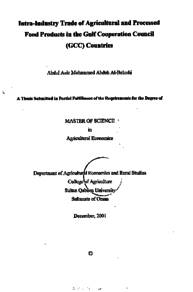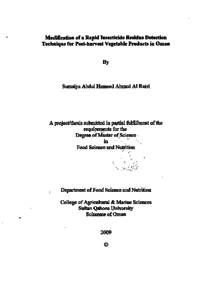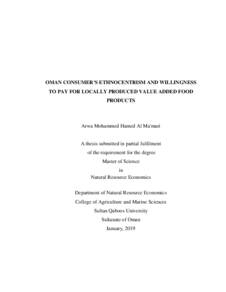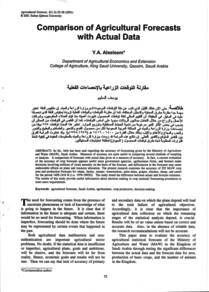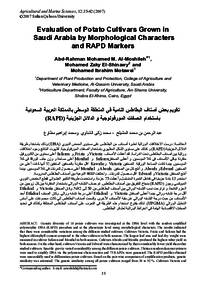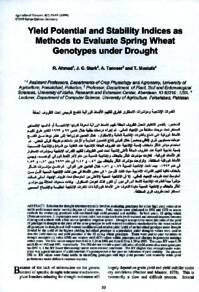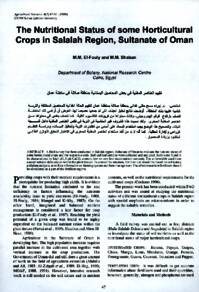Document
Intra-industry trade of agricultural and processed food products in the Gulf Cooperation Council (GCC) countries
Publisher
Sultan Qaboos University
Gregorian
2001
Language
English
Subject
English abstract
ABSTRACT
Since the 1980's we have observed the emergence of a new regional agreement among the Arab Gulf countries. In 1983 the member states implemented a free trade agreement under " The Unified Economic Agreement". One of the important purposes of the agreement was to promote trade liberalization and create a free trade area among member states. Despite the implementation of the above agreement over 19 years ago, the process of economic integration among Gulf Cooperation Council (GCC) countries remains weak, generally from the perspective of trade for agricultural and processed food products.
The main objective of this thesis is to provide various indicators of the nature of the trade activity to discover the effect of the economic integration on trade patterns and related issues. The study also, examines GCC bilateral trade patterns for agricultural products during the period of 1984-1997, to determine if trade volume has increased, and to identify the nature of trade which can be inter or intra-industry trade (IIT) by using the index of Intra-Industry Trade (UT) as an indicator of economic integration. In addition, it tests empirically the determinants of IIT between GCC countries.
The results of this study related to the principle of Comparative Advantage indicate that Oman and UAE have kept their strong specialization in agricultural and manufactured goods. Meanwhile, other GCC countries appear to have a Comparative disadvantage in both industries, with the exception of Qatar and Kuwait, which specialized in capital-intensive goods.
The analysis of agricultural products IT share shows that there are countries characterized by a high share of IIT, particularly important for UAE, KSA and Bahrain. Meanwhile, other GCC countries are characterized by an inter-industry trade specialization. This phenomenon is true for Oman, Kuwait and Qatar. Analysis of determinants indicates that almost all variables have the expected sign and are statistically significant with the exception of the distance variable which reflect the transportation costs. The over all results indicate that the GCC intra-industry Trade in agricultural and processed food products is too low and their economies less integrated with itself, Therefore, the integration of the GCC economies will be associated with a need of road transportation and communication system improvement, need to effective exploitation of the available national resoures, degree of processing for agricultural products and harmonization of sectoral, institutional laws and macroeconomic policies.
Description
Thesis
Member of
Resource URL
Arabic abstract
برز في بداية عقد الثمانينات ظهور تكتل إقليمي بين دول الخليج العربية والذي سمي فيما بعد "مجلس التعاون لدول الخليج العربية". في عام 1983 قامت دول المجلس بتطبيق اتفاقية تجارة حرة فيما بينها سميت " الإتفاقية الاقتصادية الموحدة" والتي كانت من أهم أهدافها تحرير التجارة وخلق منطقة تجارة حرة بين دول الأعضا بالرغم من مرور أكثر من 19 عاما على تلك الاتفاقية،إلا أن عملية التكامل الاقتصادي بين دول الخليج ظلت ضعیفه عموما وخصوصا فيما يتعلق بعملية التبادل التجاري للمنتجات الزراعية والأغذية المصنعة. هدفت هذه الرسالة إلى تسليط الضوء على العديد من المؤشرات عن طبيعة النشاط التجاري وذلك بهدف معرفة أثر التكامل الاقتصادي على شكل التبادل التجاري إضافة إلى شرح العديد من القضايا المهمة ذات العلاقة. كما قدف الدراسة إلى توضيح شكل التجارة الثنائية لدول الخليج للمنتجات الزراعية خلال الفترة ما بين ۱۹۸4–۱۹۹۷ وذلك لتحديد فيما إذا كانت هناك زيادة في حجم التجارة الثنائية وكذلك تحديد طبيعة ذلك التبادل سواء كانت Intra - Industry Tradeمن خلال استخدام النموذج (IIT) Intra - Industry Tradeكمؤشر للتكامل الاقتصادي، بالإضافة إلى القيام بقياس العوامل المرتبطة بالتكامل الاقتصادي بين دول المجلس. تشير نتائج تحليل الميزة النسبية بأن سلطنة عمان ودولة الإمارات العربية المتحدة تتخصصان في إنتاج السلع الزراعية والصناعية في ذات الوقت لا توجد هذه الميزة في دول الخليج الأخرى باستثناء كل من دولتي قطر والكويت اللتان تتخصصان في انتاج السلع كثيفة رأس المال . توضح نتائج النموذج IT كمؤشر للتكامل الاقتصادي بأن هناك دولا تمتاز بمعدلات مرتفعة للتبادل التجاري مع بقية دول المجلس في المنتجات الزراعية كدولة الإمارات العربية المتحدة والمملكة العربية السعودية والبحرين ، بالمقابل تتصف بقية الدول معدلات منخفضة للتبادل التجاري. كما تشير النتائج بأن جميع العوامل المحددة للتكامل الاقتصادي بين دول المجلس جاءت نتائجها وفق ما نصت عليه فرضيات التجارة الدولية وهي ذات مستوى معنوية عالية باستثناء عامل المسافة والذي يعكس تكاليف النقل. تشير النتائج النهائية بأن التكامل الاقتصادي في دول مجلس التعاون الخليجي في مجال تبادل المنتجات الزراعية والأغذية المصنعة ظل ضعيفة، وعليه فإن تطور عملية التكامل بين دول المجلس سيرتبط بعدة عوامل أهمها أن هناك حاجة لتطوير شبكة المواصلات البرية ونظم الاتصالات، وفعالية إستغلال الموارد الطبيعية، وكذلك على درجة معالجة وتصنيع المنتجات الزراعية وأخيرة ضرورة توحيد سياسات الاقتصاد الكلي
Category
Theses and Dissertations

